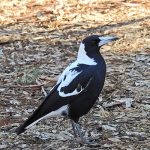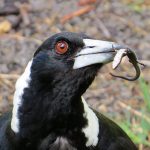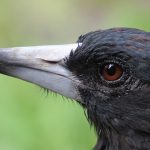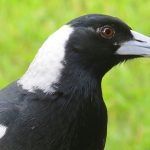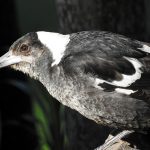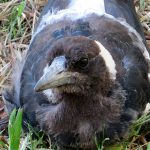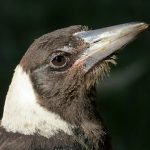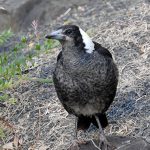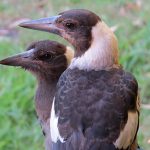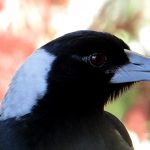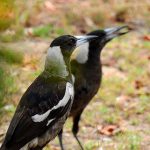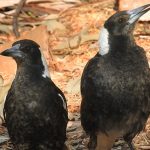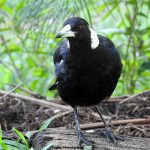AUSTRALIAN MAGPIE
The Australian Magpie: Nature’s Occasionally Cheeky Songbird
Australian Magpies are among the world’s most intelligent birds, passing some cognitive tests with flying colours.
The Australian Magpie, also an avian superstar with the voice of an opera singer and, at times, the swagger of an overly dedicated bodyguard.
1. Identification and Plumage Patterns
- Colours: Predominantly black and white, but as with all fashion, details vary:
- Male: White nape, upper tail, and shoulder
- Female: These “white” areas are a steely grey twist
- Regional Variation: In the south-east, centre, south-west, and Tasmania, you’ll find the glamorous White-backed Magpie with its entirely white back and rump.
- Eyes: Adults sport chestnut brown eyes—nature’s way of adding a little warmth to an otherwise monochrome palette.
2. Nesting Habits and Breeding
- Construction: Magpies are creative nest-builders, using sticks, grass, string, rope, wire and yep… whatever’s lying around… .
- Location: High up in trees, where views are better and nosy neighbours (read: predators) are fewer.
- Recycling Enthusiasts: They repair and reuse their nests every year. Who knew magpies were so eco-conscious?
- Breeding Season: June to December
- Incubation: ~21 days
- Nestling Period: 4 weeks
- Launching the Young: Fledglings leave early—think of it as a teensy push out of the nest, only literally. Fledglings leave the nest before they can fly, cheered on by proud—if slightly anxious—parents. They flutter from bush to bush, parents in hot pursuit with snacks.
Fun to Watch—At a Respectful Distance
Young magpies learning from their parents are a joy—nature’s comedy show (no tickets needed). But please, respect their need for distance and leave them alone. The parent birds know what they are doing.
3. Why Your Garden Loves Magpies
- Diet: Insectivores supreme—munching on bugs that fancy your foliage. Fewer pesticides needed!
Magpies do double-duty as pest controllers, snatching up insects with gusto. Avoiding insecticides keeps their gourmet buffet safe—and your garden thriving.
- Garden Care Tips:
- Skip the bug sprays—save your magpies (and your ecosystem).
- Don’t feed them processed foods; instead, a simple bird bath does wonders.
4. Swooping Magpies: The Ultimate Helicopter Parents
Ah, the legendary swoop! In spring, some magpies become swoopy to defend their nests, turning from crooners into corridor monitors.
Why the Aggression?
- Only some magpies swoop, usually if they remember previous “trespassers.”
- They remember faces and have favourite humans (and possibly a few grudge matches).
- Removing them isn’t helpful—they can’t be relocated (the young depend on them!) and new magpies will move in anyway.
Swooping Survival Tips
- Avoid known “swooping zones” during nesting season (a great excuse for a scenic detour!).
- Carry an umbrella or wear a hat—protection with a touch of personal style.
- Walk on the opposite side of the danger zone, if feasible.
- Put up signs to warn other humans—magpies don’t read, but cyclists and joggers will thank you.
5. A Feathered Maestro: The Song of the Magpie
Magpie Melodies: Not Your Average Beep and Tweet
- Wide Vocal Range: Magpies boast one of the broadest vocal cords in bird-dom, producing an incredible variety of sounds spanning several octaves—think of an opera singer with a loop pedal and a whimsical streak.
- Complex Calls: Their songs aren’t just tuneful; they’re complex arrangements with fluting notes, clicking tones, and warbles. Some phrases even sound eerily like the opening bars of a symphony or the wind in gum trees.
- Repertoire: Each magpie can belt out over 300 distinct calls. And just to keep things interesting, magpies have been known to mimic dogs, other birds, and even snippets of human speech—call them feathered remix artists!
- Purpose: Singing helps magpies defend their patch, attract mates, and keep their family group together—it’s the bird equivalent of a catchy group chat alert.
- Morning Calls: The iconic “carolling” is especially strong at dawn, waking you up with a natural alarm clock. No snooze button needed—just enjoy!


